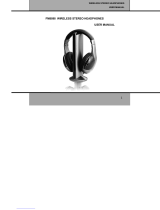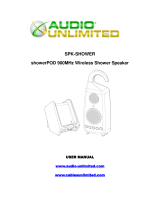Audio Unlimited SPK-SHOWER2 User manual
- Category
- Soundbar speakers
- Type
- User manual
This manual is also suitable for

SPK-9100
900MHz Wireless Stereo
Headphones
User Manual
www.audio-unlimited.com
www.cablesunlimited.com
1
INTRODUCTION
Thank you for purchasing our 900Mhz compact cordless stereo headphone system
that takes advantage of the very latest advances in wireless transmission technology
so you can listen to music or the sound from your TV both in the house and outdoors.
Just connect the transmitter to any audio source- DVD, CD, MP3, Blu-ray, PC, TV, VCR,
stereo system or radio (range 165 feet*).
∗ Actual range depends on ambient, local conditions.
FEATURES
1. Automatic Phase Lock Loop (PLL) scanning system on headphone
2. (PLL) Transmission system on transmitter
3. Automatic battery recharging ability built into the transmitter (batteries
supplied)
4. 900 MHz RF technology allows freedom of movement
5. Transmission is not restricted solely to line of sight
6. Rechargeable receiver headphones (batteries included)
7. High-quality stereo sound is virtually interference-free
8. Automatic Level Control (ALC) and Auto On/Off function
IMPORTANT SAFETY INFORMATION
1. Read and understand all instructions.
2. Follow all warnings and instructions.
3. Before placing headphones on head, ensure that the volume is at a
comfortable level.
4. Reduce the volume or discontinue use if you experience a ringing in your ears.
5. Do not use liquid or aerosol cleaners. Use a damp cloth for cleaning. If
necessary, use a mild soap.

2
6. Do not use this product near water, for example, near a bathtub or laundry tub,
in a wet basement, or near a swimming pool.
7. Do not place this product on an unstable cart, stand or table. The product may
fall, causing serious damage.
8. Do not allow anything to rest on the AC/DC adapter cord or AUDIO IN cable.
Do not place this product where the cord can be abused by animals or
persons walking on it.
9. Never push objects of any kind into this product through the cabinet slots as
they may touch dangerous voltage points or short out parts that could result in
a risk of fire or electric shock. Never spill liquid of any kind on the product.
10. To reduce the risk of electric shock, do not disassemble this product. Opening
or removing covers may expose you to dangerous electric shock when the
product is subsequently used. Take it to a qualified service center when
service is required.
11. Unplug this product from the wall outlet and refer to qualified service
personnel under the following conditions:
a. If liquid has been spilled into the product.
b. If the product has been exposed to rain or water.
c. If the product does not operate normally by following the operating
instructions. Adjust only the controls that are covered by the
operating instructions because improper adjustment of other controls
may result in damage if the product has been dropped or the cabinet
has been damaged.
3
HEADPHONE SYSTEM PARTS LIST
FRONT VIEW
REAR VIEW

4
HEADPHONE SYSTEM PARTS LIST IDENTIFICATION
1 RF transmitter
2 RF receiver headphones
3 Power On/Off switch
4 Power On indicator light
5 Rechargeable 1.2 V 300 mAh batteries (Ni-Cd, LR03/AAA size)
6 Charge contacts
7 12V 150 mA AC power adapter (UL LISTED)
8 Jack plug adapter (3.5 mm/6.3 mm diameter)
9 RCA socket audio adapter cable, (3.5mm input jack to two RCA plugs)
10 Operating indicator light (power)
11 Charge indicator light (charging)
12 Audio connection cable with 3.5mm jack
13 Volume control knob (VOL)
14 AUTO SCAN indicator
15 AUTO SCAN button
16 Battery door
17 DC IN connector
18 Audio input cable
19 Channel selector (CHANNEL 3 2 1)

5
Before Using the Headphone System
An initial 24-hour charge is required to ensure an acceptable service life for the
rechargeable batteries. Always ensure that the headphones are switched to the Off
position while the batteries are charging.
INSTALLATION
RECEIVER HEADPHONES
1. Open the cover of the rechargeable battery compartment located on the side of
the right-hand receiver headphone.
2. Insert two rechargeable LR03/AAA size batteries taking care to ensure correct
polarity.
3. Close the battery compartment cover.
TRANSMITTER
1. Connect the provided AC/DC power to an electrical outlet.
2. Connect the AC/DC power adapter cable to the DC IN input connector located on
the transmitter rear panel.
3. Plug in the AUDIO IN cable located on the back of the transmitter panel to a
headphones/earphones output on your TV, stereo system, VCR, PC, or radio.
Depending on the size of the Audio Out port of your audio component, you may
need to use the included Jack Plug Adapter. If the stereo (or other audio
component) has a two-hole Audio Out (left and right) connection, use the RCA
socket audio adapter provided. Connect it to the end of the AUDIO IN cable and
then to the Audio Out connection on the component making sure to match the
RED to RED and the WHITE to WHITE.
4. A cable is provided from the transmitter rear panel that can be connected to the
audio output (left and right) on a TV, stereo system, VCR or radio, or to a
headphones/earphones output using the connector supplied.
6
The red operating indicator will light up as soon as you have connected the power
adapter to the outlet and the audio cable to a signal source. If the operating indicator
light remains off, switch on the audio source and increase its output volume level until
the red indicator light comes on.
CHARGING THE BATTERIES
1. Place the On/Off switch on the receiver headphones in the Off position.
2. Place the headphones on the transmitter, taking care to ensure that the charge
contacts touch the transmitter's charge prongs.
3. The charge process starts automatically and the green indicator light comes on. Be
sure to charge new batteries for 24 hours before using them for the first time in the
headphones.
WARNING:
Never attempt to recharge conventional dry cells.
Never use another type of battery or non-rechargeable batteries to replace the
rechargeable (LR03/AAA) batteries supplied. When the headphones are not in use,
move the switch to the OFF position to avoid damaging the batteries. The batteries
must always be fully charged before use.
IMPORTANT:
When replacing the batteries or disposing of the unit, always comply with applicable
laws relating to the disposal of batteries. Please place them in a proper disposal
container to ensure that they are eliminated safely and in an environmentally friendly
way.

7
OPERATION
1. Switch on the sound source (TV, PC, VCR, DVD player or audio component) that
the transmitter is connected to.
2. Place the headphones On/Off switch in the On position.
3. Before placing headphones on head, make sure the volume is not too loud and
then place the headphones on your head and adjust the volume to obtain the
desired sound level.
4. There are 3 available channels. Press the Auto Scan button on the headphones
to search for the best reception. The corresponding indicator light will illuminate.
NOTE:
You should then be able to move freely from one room to another with no interference.
If interference does occur (interruptions in the signal), press the Auto Scan button once
to find a better reception channel.
A For better stereo reception, stay approximately 23 feet away from the transmitter
when you press Auto Scan.
B If it is impossible to find a satisfactory frequency, change the channel setting
(CHANNEL 3x2x1) on your transmitter, then press Auto Scan to find the
corresponding channel.
To protect the transmitter and save power, the transmitter will automatically switch off
after approximately four minutes if the signal from the audio source is too weak. If,
however, the signal returns to an acceptable level, the transmitter automatically
switches back on.
8
TECHNICAL SPECIFICATIONS
Transmission mode : UHF stereo
Carrier frequency : 900Mhz
Operating voltage : Transmitter – 12V 150 mA
Receiver – 2.4 V (two rechargeable batteries, LR03/AAA size)
Frequency response : 50 Hz – 12 KHz
Distortion : 1%
Signal-to-noise ratio : 72 dB
Channel separation : 50 dB
Range : 165 feet max.
NOTE: This equipment has been tested and found to comply with the limits for a Class
B digital device, pursuant to Part 15 of the FCC Rules. These limits are designed to
provide reasonable protection against harmful interference in a residential installation.
This equipment generates, uses and can radiate radio frequency energy and, if not
installed and used in accordance with the instructions, may cause harmful interference
to radio communications. However, there is no guarantee that interference will not
occur in a particular installation. If this equipment does cause harmful interference to
radio or television reception, which can be determined by turning the equipment off and
on, the user is encouraged to try to correct the interference by one or more of the
following measures:
-- Reorient or relocate the receiving antenna.
-- Increase the separation between the equipment and receiver.
-- Connect the equipment into an outlet on a circuit different from that to which
the
receiver is connected.
-- Consult the dealer or an experienced radio/TV technician for help.
Changes or modifications not expressly approved by the party responsible for
compliance could void the user’s authority to operate the equipment.

9
TROUBLESHOOTING
NO SOUND
- Ensure that the AC power adapter is pushed fully into the power outlet and
that its cable is properly connected to the DC IN 12V connector on the
transmitter.
- Ensure that the headphones On/Off switch is in the On position.
- The headphones battery charge level may be too low. Recharge the
batteries or replace them with fully charged batteries.
- Ensure your TV set, stereo system, VCR, DVD player or audio component
is switched on and set to a channel that broadcasts an audio signal.
- The connected audio/video equipment may not be in playback mode. Start
playback on the equipment.
- Ensure the source is broadcasting at a sufficient volume by increasing the
volume as needed on the source component. Use the headphones volume
control to increase the sound level.
- Check the battery compartments to ensure batteries are fully seated and
that polarity positions are correct.
DISTORTION
- Ensure that the "Stereo" indicator is lit. If not, press the autoscan button on
the headphones until it illuminates.
- Use the channel selector to change the transmitter's frequency. Press the
auto tune button on the headphones until the "Stereo" indicator comes on.
- The headphones battery charge level may be too low. Recharge the
batteries or replace them with fully charged batteries.
- The headphones may be too far away from the transmitter. Move to a
location closer to the transmitter.
- The audio signal input level may be too low. Increase the volume from the
audio source.
10
FOR MAXIMUM PERFORMANCE
When available, a variable output on the source component will offer increased volume
control and help reduce distortion. Examples of variable outputs are headphone jacks,
computer speaker outputs and some TV RCA output jacks.
a. When using a variable output jack, set the volume of the source
component to mid-level and adjust headphone volume control until
desired result is achieved. If headset volume is not sufficient, adjust
source volume. If distortion in the headset occurs, reduce volume
control on source component.
b. Fixed outputs allow for volume regulation through the headset only.
Examples of fixed outputs are RCA jacks (VCR, Tape, Video or CD
outputs).
IC Statement:
Operation is subject to the following two conditions: (1) this device may not cause
interference, and (2) this device must accept any interference, including interference
that may cause undesired operation of the device.
-
 1
1
-
 2
2
-
 3
3
-
 4
4
-
 5
5
-
 6
6
Audio Unlimited SPK-SHOWER2 User manual
- Category
- Soundbar speakers
- Type
- User manual
- This manual is also suitable for
Ask a question and I''ll find the answer in the document
Finding information in a document is now easier with AI
Related papers
Other documents
-
Audiovox 128-5971 User manual
-
C2G 41313 Owner's manual
-
 SHENZHEN YUXINXIN ELECTRONICS ZRH2012010603A User manual
SHENZHEN YUXINXIN ELECTRONICS ZRH2012010603A User manual
-
 Recoton AW721 User manual
Recoton AW721 User manual
-
ALDI Tevion JS-W002 User manual
-
Altec Lansing AHP612 User manual
-
Acoustic Research AWD204 User manual
-
Uni-Art Precise Products K912 User manual
-
Advent AW720 Operating instructions
-
Sharper Image TV Wireless Headphones Owner's manual












